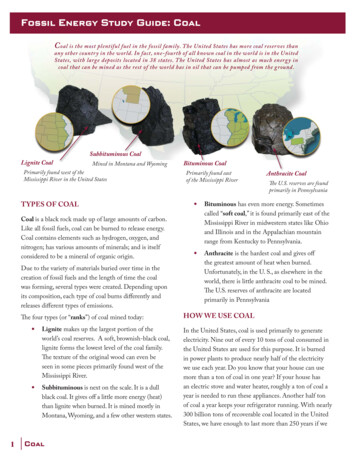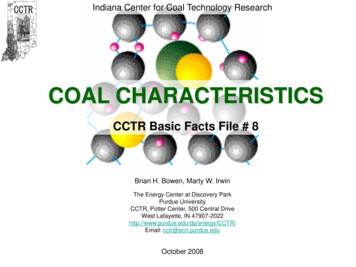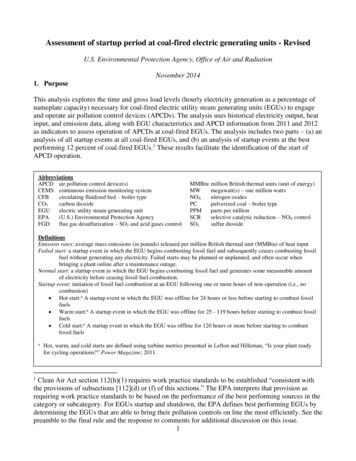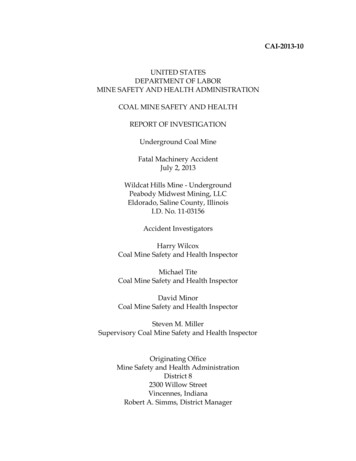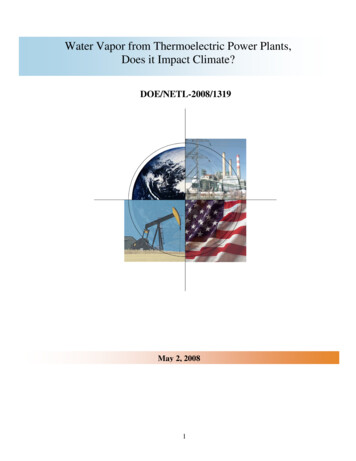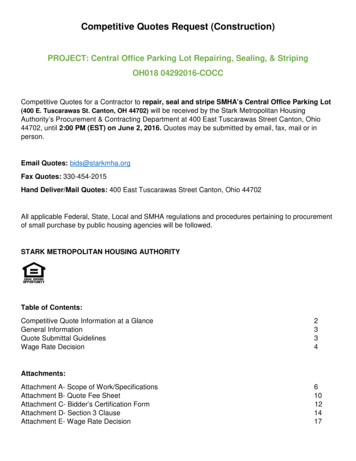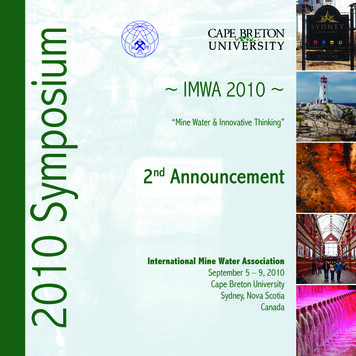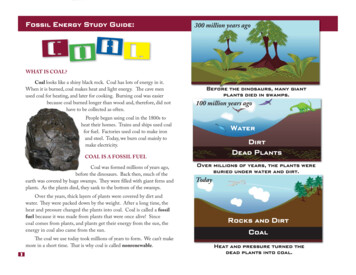
Transcription
DEPARTMENT OF THE 1NTEKIOKUNITED STATES GEOLOGICAL SURVEYGEORGE OTIS SMITH, DIRECTORIX 371RECONNAISSANCEOf THEBOOK CLIFFS COAL FIELDBETWEEN GRAND RIVER, COLORADOAND SUNNYSIDE, UTAHBYG. B. RICHARDSONWASHINGTONGOVERNMENT.PRINTING1909OFFICE
CONTENTS.Page.Introduction.Topography.57Relief and drainage.8Lowland at base of Book Cliffs.9Book Cliffs.Book or Tavaputs Plateau.Climate and culture .101011Descriptive geology.11Stratigraphy.Cretaceous system.Dakota sandstone.Mancos shale.Mesaverde formation.Tertiary system Eocene series.Structure.Coal.General statement.Occurrence and thickness.Amount of available coal.Character and use of Book Cliffs coal.Physical properties.Chemical composition.Market and 474853
ILLUSTRATIONS.PLATE I. Map of part of the Book Cliffs coal field.II. A, Bench at base of Book Cliffs, east of Thompsons; B, Fault inMesaverde formation, 2 miles south of Carbonera.III. Generalized columnar section of the rocks of the Book Cliffs coalfield.IV. Mount Garfield, 9 miles east of Grand Junction.V. A, Typical exposure of Mesaverde formation, north of Thompsons:B, Outcrop of coal in valley of Saleratus Creek.VI. Detailed columnar sections of coal-bearing rocks in Book Cliffs field.VII. Little Book Cliffs and Grand River northeast of Palisades.VIII. Coal sections in Book Cliffs coal field.IX. A, Ballard's coal mine, north of Thompsons; B, Outcrop of coal atentrance to Ballard's mine, showing jointing of coal.X. Property of the Book Cliff Mine Company at the base of the cliffsnorth of Grand Junction.FIGUKB 1. Map showing relation of the Book Cliffs field to adjacent coal fields.Page.51012141(522242438487
U.S.GEOLOGICAL SURVEYGEORGE OTIS SMITH, DIRECTORBULLETIN NO. 371PL.I.:TjaH,FIEI.D COCO.I , I I hLIST OF MINES AND eo mine.Prospect on upper coal.Mt. Lincoln mine.Riverside mine.Prospect on upper coal.Palisade mine.Garfleld mine.Prospect on lower coal.Old Book Cliff mine.Book Cliff mine.Keystone or Steele mineBlack Diamond mine.Farmers mine.Bob Cat mine.Excelsior mine.Corcoraa mineHunter mine.Kiel or Gross mine.Nugent mine.Nearing mine.Mott prospect.Johnson mine.Lane mine.Prospect.Uinta Railroad Company's mineCoal outcrop.Coal outcrop.Coal outcrop.Ballard mine.Prospect.Prospect.Black Baby minePeterson's prospectProspect.Prospect.Horse Canyon mine.rB E C K W 1 T H5 113 HI*109 107 O5 !O310!EoceneIn Book. Cliff's area.)Varicolored, shales,'baft'saiidstoTLe,thiii liaitistc»iie.Jandbasal con lomeracbe13'III".-109 107sIO5 Mesavraxle formationManeos shaleDakota, sandstoneAlternating mff sand- Bleuiktx) daifcolay sliale, Buff sandstone and constone and dark shalewitKTforkablftlieds ofcoal in the; "lower partfevrlense.s of limestone,aiulth.iit'becls of loiiffsaxid.stone at the topProspect1O315. loiriei'atje,occa,siorj alshale andlo w-gi'ad.e coal.so milesBase compiled froTi Hayden and Poweil surveysU.S. Land Office and railroad mapsi 10 ! 30'feetr-- o ooo4 OOO2000RECONNAISSANCE .MAI' AND CROSS SECTION OF PART OF THE BOOK CLIFFSBy CiB-Kiekardscm and L.J.Pe;ppe,rberg, LHO619O8COAL FIELD, COLORADO AND UTAH.OD QOO./f8 000
RECONNAISSANCE OF THE BOOK CLIFFS COAL FIELD,BETWEEN GRAND RIYER, COLORADO, AND SUNNYSIDE, UTAH.By G. B. RICHARDSON.INTRODUCTION."The Book Cliffs coal field is part of the southern rim of the UintaBasin, which is an immense structural trough in western Coloradoand eastern Utah, around whose margin the outcrop of coal-bearingrocks can be traced for more than 500 miles. (See fig. 1.) Fromthe vicinity of Mount Hilgard, in central Utah, northward to Castlegate, the coal measures form the eastern escarpment of the WasatchPlateau. Thence they trend southeastward to Grand River, outcropping in the Book Cliffs. Beyond Grand River they continueeastward, forming the southern face of Grand Mesa, to the vicinityof Crested Butte. From this point the coal-bearing rocks trendnorthward and cross Grand River again near Newcastle. Northof Grand River they form the Grand Hogback, and beyond the Danr\forth Hills the trend is westward along" the southern flank of theUinta Mountains. This great basin of coal-bearing rocks has beenbut partially prospected, arid mines are in operation in only a fewlocalities, but enough of the area has been explored to prove thatit is one of the most important coal reserves of the Rocky Mountainregion. As a whole, this area is a distinct unit, but for convenienceof study and description, it is divided into several parts. The BookCliffs field is that portion of the southern rim of the Uinta Basinwhich includes the Book'Cliffs and lies between Grand River, Colorado, and the Wasatch Plateau, Utah.The geology of the Book Cliffs was first studied by A. C. Peale,*of the Hayden Survey, who in 1876 examined the eastern part ofthe field. The western part was included in G. H. Eldridge's mapof the Uinta Basin published in connection with his study of asphaltand bituminous rock deposits/ Until recently these papers have j An abstractor this report was printed in Contributions to Economic Geology, 1906, Part II: Bull. U. S.Geol. Survey No. 316, 1907.ftPeale, A. C., Geological report on the Grand River district: Tenth Ann. Kept. U. S. Geol. and Gcog." Survey Terr., 1878, pp. 170-185.cEldridge, G. H., Asphalt and bituminous rock deposits of the United States: Twenty-second Ann.Kept. U. S. Geol. Survey, pt. 1, 1901, p. 332.5
6THE BOOK CLIFFS COAL FIELD.been the only available systematic geologic reports of the region.The presence of coal in the Book Cliffs has long been known. Thedeposits are mentioned by R. C. Hills 0 in his report on the coalfields of Colorado, and by L. S. Storrs 6 in his paper on the RockyMountain coal fields. Arthur Lakes has also referred to part ofthe area c and has described the Book Cliff mine.d But the coal fieldwas not examined in detail until 1905, when J. A. Taff, e of the UnitedStates Geological Survey, studied the western part of the field fromthe vicinity of Sunnyside to Castlegate, Utah, and its southern continuation along the escarpment of the Wasatch Plateau.During three months of the season of 1906 the writer, assistedby W. D. Neal, L. J. Pepperberg, and C. D. Perrin, made a reconnaissance survey of the eastern part of the Book Cliffs field fromGrand River westward to the termination of Taff's work. Theattention of the party was devoted mainly to a study of the occurrence of the coal. The boundary between the Mancos shale andthe Mesaverde formation the most easily recognized horizon nearest the coal was followed throughout the field, but in the timeavailable detailed mapping of the formations could not be attempted.The location of the Dakota sandstone outcrop below the Mancos shaleand the position of the base of the Eocene above the Mesaverde formation were determined only at certain localities, and the boundarybetween these formations, shown on Plate I by a dotted line, is onlyapproximately located.TOPOGRAPHY.The Book Cliffs form the southern margin of the Book or TavaputsPlateau, which is situated in the central part of the Colorado Plateauprovince, between the Rocky Mountains and the Wasatch Range.The southward-facing cliffs, which, extend in a great east-west linefrom Grand River to Castlegate, lie north of and generally in sightof the Denver and Rio Grande Railroad and are one of the mostI striking topographic features along that railroad. The cliffs do notI form an unbroken wall, but locally are deeply cut by small streamsUnto a series of spurs which, although much lower than the mainmass of the plateau to the north, tower above and dominate thegreat plain at their base. This plain is eroded in the soft shaleunderlying the coal-bearing rocks, and it affords a route for therailroad which closely skirts the foot of the cliffs throughout most. "Hills, R. C., Coal fields of Colorado: Mineral Resources U. S. for 1892, U. S. Geol. Survey, 1893, p. 353.* Storrs, L. S., The Rocky Mountain coal field: Twenty-second Ann. Kept. U.S. Geol. Survey, pt. 3,1901,p. 436.c Lakes, Arthur, The Grand River coal field: Mining Reporter, vol. 51, 1905, pp. 379-381.d Lakes, Arthur, The Book Cliffs coal mine: Mines and Minerals, vol. 24, 1904, pp. 289-291.eTaff, J. A., The Book Cliffs coal field: Bull. U. S. Geol. Survey No. 285, 1906, pp. 289-302.
TOPOGRAPHY.7of their extent. South of this broad valley stratigraphically lower iand harder rocks are exposed in the Uncompahgre Plateau and the 'San Rafael Swell, two great anticlinal uplifts south of the UintaBasin.
8THE BOOK CLIFFS COAL FIELD.RELIEF AND DRAINAGE.The altitude of the surface throughout the Book Cliffs field rangesfrom about 4,000 feet in the lowlands to 8,000 and 9,000 feet abovesea level on the plateau. The area is drained by Green and Grandrivers, which unite to form the Colorado about 60 miles south ofthe Book Cliffs.Green River, after leaving the Uinta Mountains, flows in a southwesterly direction across the Uinta Basin and cuts through theTavaputs Plateau in a steep, narrow gorge known as " DesolationCanyon." M the mouth of the canyon in the Book Cliffs the streamemerges into the lowlands, where it meanders in a broad valley for10 or 12 miles. It flows across the belt of lowland and enters another canyon on its way to its junction with the Grand. GreenRiver receives a number of large tributaries in the Uinta BasinYampa and White rivers on the east and Uinta and Duchesne onthe west; but in its canyon course through the Tavaputs Plateauthe only important branch is Price River, and in the lowland southof the Book Cliffs there is no addition to its flow. East of DesolationCanyon the plateau drains northward by Kwiant and Yogowotsicreeks, which, rising near the rim of the Book Cliffs, enter the rivera few miles below the mouth of White River.Price River rises on the Wasatch Plateau, flows southeastward,and emerges from the canyon it has cut in the plateau at Castlegate.Thence it flows along the broad lowland valley at the base of theBook Cliffs for a distance of 25 miles. Instead of continuing in thelowland, however, it crosses the northern end of the San Raf ael Swell,flows directly across the lowland valley again, cuts a deep canyonwhich separates Beckwith Plateau from the Tavaputs Plateau, andfinally enters Green River about 6 miles above the mouth of Desolation Canyon.Grand River, rising near the Continental Divide, on the Front Rangeof the Rocky Mountains, in Middle Park, Colorado, flows southwestwardand enters the area under consideration at the mouth of Roan Creekin a relatively broad valley. A few miles below Roan Creek the riverenters Hogback Canyon, in which it flows through the Little BookCliffs and emerges into the lowland immediately above the town ofPalisades. The river crosses the lowland, a distance of about 13 miles,to the town of Grand Junction, where it is joined by Gunnison River.The Grand then turns abruptly northwestward and follows the southern margin of the lowland for 18 miles. Below Fruita it leaves thelowland, and again flowing southwestward cuts across the northernend of the Uncompahgre Plateau, and continuing southwestward,mostly in a canyon course, finally joins the Green.With the exception of the Gunnison, Grand River receives no largetributaries in the Book Cliffs field. The most important is Roan
TOPOGRAPHY.9Creek, which drains the area between the Little Book Cliffs and theBook Plateau northwest of De Beque. The streams which flow southward from the Book Plateau are small, and on account of the slightprecipitation and limited drainage area flow intermittently throughout the year. During the dry months the discharge even within thehighlands almost ceases and the stream beds across the lowlandsare dry.The relation of the through-flowing streams to the lowland indicates that their general courses were defined before the developmentof the present topography, for there is little adjustment between thedrainage and the outcrops of the hard and soft formations. GrandRiver conforms only partially with the trend of the lowland; GreenRiver maintains its way directly across the shale belt; Price River,flowing alternately over hard and soft rocks, instead of continuouslyin the shale lowland, is a good example of superimposed drainage.LOWLAND AT BASE OF BOOK CLIFFS.The lowland at the base of the Book Cliffs extends in a curved butgeneral westerly direction from Palisades, Colo., to Helper, Utah, adistance of 190 miles. From Palisades it continues southeastwardbetween the Uncompahgre Plateau and Grand Mesa, and from Helperthe lowland extends southward between the San Rafael Swell and theWasatch Plateau, where it is known as Castle Valley. Throughoutits extent the lowland is underlain by shale and is not a stream valleyin the sense of being carved and occupied by a single master stream;instead, the lowland has been eroded in soft rock by general subaerialaction and forms part of several drainage basins. The lowland hasbeen widened by the gradual recession of the Book Cliffs northwarddue to the weathering of the soft shale and the undermining of theoverlying hard sandstone which forms the cliffs. By this process thecliffs have retreated, but they have maintained a fairly regular front.The average width of the lowland is about 12 miles, having a maximum of 23 miles, in the vicinity of Cisco, and a minimum of 4 miles,near Woodside. The lowland is an undulating plain that rises gentlytoward the bordering highlands and extends between the Book Cliffson the north and a belt of sandstone hills on the south. It practicallycoincides with the outcrop of the Mancos shale. The small streamsthat head in the Book Cliffs and cross the lowland have carved steeparroyos, which impede travel. In the vicinity of the cliffs there areoutlying buttes and the shale is eroded into badlands. Adjoining thecliffs there are local fringing remnants of an old outwash gravelcovered plain into which the streams have cut their way 100 feet ormore, and south of Grand River, near Palisades, a number of terracesare well developed. The largest, about 150 feet above the river, is
10THE BOOK CLIFFS COAL FIELD.between a quarter and a half mile wide, and traces of several other lessdistinct terraces have been found above this one.BOOK CLIFFS.The Book Cliffs occupy a belt from 1 to 10 miles wide and rise abovethe adjacent lowland from 2,000 to 6,000 feet. In places the rise isabrupt in one or two sharp precipices; elsewhere it is accomplished bya series of cliffs and intervening benches. The rocks composing theescarpment are alternating beds of sandstone and shale dippingslightly northward, and the strata present the appearance of the leavesof a book lying flat, hence the name.In the area here discussed the cliffs extend in an S-shaped belt fromPalisades to Sunnyside. At the east they are much dissected byRoan Creek, and a subordinate escarpment known as the Little BookCliffs extends northwestward from the mouth of Hogback Canyon.The top of the Little Book Cliffs marks the crest of a ridge whosenortheastern flank constitutes a dip slope, and the area between LittleBook Cliffs and Roan Creek is a gentle northeastward-sloping monocline dissected by southeastward-flowing streams.West of the headwaters of Roan Creek the Book Cliffs proper extendto the end of the area mapped. Erosion by East and West Saltcreeks has caused the rim of the plateau to recede so much that a fewmiles east of the Utah-Colorado boundary the distance between thelowlands and the plateau is unusually great. Between the State lineand Green River the average distance is about 10 miles. Here a lowbench, caused by a great lens of sandstone in the shale, forms the baseof the cliffs, as shown in Plate II, A. Above this lowest bench thereis a succession of dissected platforms and escarpments up to thesummit of the plateau.Green River has cut another embayment in the cliffs, and PriceRiver in its canyon course separates a small area, known as the Beckwith Plateau, from the main mass of the upland. The BeckwithPlateau is considerably dissected on the north and east, but faces thelowland on the west in a practically unbroken scarp more'than 1,500feet high. Beyond Price River a similar line of cliffs extends at leastas far as Sunnyside. The surface at the summit of this cliff slopeseastward and forms a platform upon which another but moredissected line of cliffs rises 1,500 feet higher.BOOK OR TAVAPUTS PLATEAU.The crest of the Book cliffs forms the southern rim of the BookPlateau, or, as it is known in Utah, the Tavaputs Plateau, whichviewed from the south, forms an even-topped sky line. The plateauslopes gently northward toward the axis of the Uinta Basin, but ismuch dissected by deep canyons.
U. S. GEOLOGICAL SURVEYA.S.BULLETINNO. 371BENCH AT BASE OF BOOK CLIFFS, EAST OF THOMPSONS.FAULT IN MESAVERDE FORMATION, 2 MILES SOUTH OF CARBONERA,PL.
STRATIGRAPHY.11CLIMATE AND CULTURE.The climate of the region is arid, the mean annual rainfall at GrandJunction being only 7.8 inches. The vegetation, therefore, is of thedesert type, and the shale lowland in its natural state is practicallybare or yields a meager growth of desert plants. The uplandsreceive more rain and support stunted conifers, oaks, etc. In general, timber suitable for mining purposes is scarce. In the GrandJunction region timber for this purpose is imported, but in the westernpart of the field it is more plentiful. In the valleys where irrigationis practiced the desert has been converted into a garden, and portions of the area rival in productiveness any part of the country.The mean annual temperature is 53 , the summers being warm andthe winters usually mild. The percentage of sunshine is 75 and general climatic conditions are delightful. In the irrigated areas contigUOUS to Grand, Green, and Price rivers there are a number ofthriving settlements where fruit growing is an important industry.Grand Junction, the most important place in the field, is a typicallyprogressive western town. The lowland is traversed in an east-westdirection by the main line of the Denver and Rio Grande Railroad.DESCRIPTIVE GEOLOGY.STRATIGRAPHY.The general sequence of formations in the coal fields of the UintaBasin, as determined by recent work of the United States GeologicalSurvey,a is shown in the following table:Geologic formations in Uinta n Kiver formation.Wasatch formation.Fort Union or older (?).Unconformity.Cretaceous.Upper Cretaceous.Mesaverde formation.Mancos shale.Dakota sandstone.Unconformity.Jurassic.To the subdivisions of the Cretaceous are given the names introduced by Whitman Cross for southwestern Colorado.6 This classia Tafl, J. A., Pleasant Valley coal district, Utah, and Gale, Hoyt S., Coal fields of the Danforth Hills andGrand Hogback, Colorado: Bull. U. S. Geol. Survey No. 316,1907.& Cross, Whitman, La Plata folio (No. GO), Geologic Atlas U. S., U. S. Geol. Survey, 1899.
12THE BOOK CLIFFS COAL FIELD.fication differs from that of Peale, of the Hay.den Survey, who in hisreport on the Book Cliffs field 0 separated the rocks here assigned tothe Mesaverde formation into the "Fox Hills" and the "Laramie."It was recognized by the Hayden Survey that there is. no distinctlithologic break in the Book Cliffs between the "Laramie" and the"Fox Hills," and the nomenclature employed was an attempt toconform to subdivisions used in other fields. It has been found desirable, however, to restrict the use of the name "Fox Hills" to the original area in South Dakota,6 and, as shown below, these rocks are notLaramie, but belong in the Montana group. The classification hereadopted is based on the general stratigraphic and areal relations ofthe rocks and on fossil evidence, as explained on pages 17-19. TheUinta Basin section differs from that of southwestern Coloradoand the Tampa coal field in northwestern Colorado 0 by theabsence of the Lewis shale and the Laramie formation betweenthe Mesaverde and the Eocene. This hiatus in the Book Cliffs fieldappears to be accounted for. by the unconformity at the base of theEocene, which implies that these formations, if they were ever present in the area under discussion, were removed by erosion previousto the deposition of the overlying Tertiary rocks.In the Book Cliffs field the general character and sequence of therocks is shown by the section in Plate III. The strata are separableinto four distinct lithologic divisions, the three Cretaceous formations named and the Eocene rocks, all easily recognizable throughoutthe field by their physical character and sequence.CRETACEOUS SYSTEM.DAKtTTA SANDSTONE.The Dakota sandstone in the area here considered possesses the characteristic features common to the formation in this general region. Itis composed of buff quartzitic sandstone, generally conglomeratic, andlocal beds of carbonaceous shale and low-grade coal are provisionallyincluded in the formation, although no fossils have been found in themin the Book Cliffs field. The Dakota varies in thickness from about200 feet to less than 25 feet. The outcrop forms a narrow belt of lowhills parallel to and about 12 miles south of the Book Cliffs.The formation is extremely variable in composition and arrangementof the beds, as shown by the following sections measured in differentparts of the field. At the mouth of Gunnison River, south of Grand« Peale, A. C., Geologic report on the Grand River district: Tenth Ann. Kept. U. S. Geol. and Geog.Survey Terr., 1878.6 Stanton, T. W., Geology and paleontology of the Judith River beds: Bull. U. S. Geol. Survey No. 257,1905, p. 66. Fenneman, N. M., and Gale, Hoyt S., The Tampa coal field: Bull. U. S. Geol. Survey No. 297,1906.
BULLETIN NO. 371U. S. GEOLOGICAL SURVEYAGE.FORMATION.«c§Mostly Wasatch.THICKNESS,SECTION.PL. IllDESCRIPTION.IN FEET.gjgjfe .Varicolored shales. ImfT sandstone, local basalconglomerate, and subordinate thin foedsot linic s mrrrsections show diverse stratigraphy. These rocksform the highest clilts and constitute the floor ofthe Uintii Jiasin.' . . - -T-I r i j » j - j-.-/ - . -.!!- -. -:' J, ff :- 14. - .'. j-i; i -' ' ' ' ' ' '.iiii-iii:-.ij; ! LJlesaverde. L-- -L U' '' ' ' ' ' ' L '- - ' ' ' '1.200 to 2,200Alternating beds of buff sandstone and drab shalewith workable beds of coal in the lower part ofthe formation. Fossils occurut several horizons.BookClilfs. k -s - i -' ' i . . . . .: -r' -:r -:: Cretaceous.p j t4 Daa.P - -r z -i:Mancoa shale.3,000 E r:tion. This shnle underlies the broad lowlandat the base of the Book dill's. -T .-Fissile black to drab clay shale and local lenses oflimestone. Thin beds of buff sandstone at the topmark the transition to the overlying formation. . "Dakota sandstone.25 to 200Ii3-J300 Morrison.Buffi sandstone, often conglomeratic.Red, green, and purple shales with lensns and thinbedsof bun" sandstonecontainingdinosaur bones- GENERALIZED COLUMNAR SECTION OF THE ROCKS OF THE BOOK CLIFFS COAL FIELD.
STRATIGRAPHY.13Junction, the following measurements were made, but no Dakota fossils were found, and the limits- of the formation were not determined:Section of strata south of Grand Junction.Feet.Shale, drab (Mancos). v.,.'.Sandstone, buff, lens (Dakota?).Shale, carbonaceous, containing thin layers of coal (Dakota?).Sandstone, massive, cross-bedded, cream-colored, quartzitic, including irregular lenses of conglomerate with rounded pebbles of chertand quartzite up to 1 inch in diameter (Dakota).Shale, drab, probably below Dakota.Sandstone, greenish drab, shaly.Shale, greenish drab.52020\.220 68Between Grand Junction and Fruita the outcrop of the Dakota liesimmediately south of Grand River, but the formation is covered bysand and gravel at many places. In this locality the carbonaceousshale is well developed, and at several places there are coal prospects.In a creek about midway between Grand Junction and Fruita the following section is exposed:Section of Dakota (?) coal beds in creek midway between Grand Junction andFruita.Sandstone, buff.Shale, carbonaceous.Coal.Shale, carbonaceous.Coal (varies from 2 to 3 feet).Shale, carbonaceous.Coal.Shale, carbonaceous.Ft.in.421126G68812 10The formation crosses the river west of Fruita and the following section was measured south of Loma:'Section of Dakota sandstone south of Loma.Shale, dark with local carbonaceous layers (Colorado).Sandstone, buff, including thin layers of shale and lenses of conglomerate with pebbles of chert and quartzite.Shale, greenish, sandy.Sandstone, bxiff, and conglomerate.Sandstone, white.Shale, varicolored (Jurassic).Feet.40502520135South of Thompsons, Utah, there are 100 feet of massive white andbuff sandstones, cross-bedded and locally conglomeratic, lying betweendrab shale above and varicolored shale below. At this place the carbonaceous beds seem to be absent, and they were not found farther
14THE BOOK CLIFFS COAL FIELD.west in the area examined. Near Green River the formation is variable. In places south of Elgin the sandstone thins out to a few feetand locally disappears, while nearby it thickens to 40 feet or more.Some exposures show considerable conglomerate, while others showbut little conglomerate aiid much sandstone.Characteristic Dakota leaves were found in the sandstone near Elginand in the vicinity of Woodside. They were examined by F. H.Knowlton, who furnishes the following lists:Dakota fossils from Woodside.Laurus proteaefolia Lesq.Laurus modesta? Lesq.Dakota fossils from Elgin.ct. Pecopteris striata Heer, from the Unter Atanekerdluk (Cenomanian)beds of Greenland.Gleichenia sp.?Torreya oblanceolataLesq.Pinus sp. (cone scales).Liquidambar integrifolium Lesq.Andromeda linearifolia? Lesq.Salix protesefolia Lesq.The Dakota sandstone is underlain by several hundred feet of red,green, and purple shales with intercalated layers of buff sandstone andthin blue limestone. A number of dinosaur a bones have been foundin these beds, which probably represent the Morrison formation. Thecontact between the Cretaceous (Dakota) and Jurassic is not everywhere distinct, but in several localities the former is exposed lying unconformably on an undulating surface of varicolored Jurassic shale.MANCOS SHALE.The Mancos shale forms the base of the Book Cliffs (Mount Garfield,PI. IV), where it is sculptured into badland topography, and itunderlies the broad valley between the cliffs and the hills of Dakotasandstone to the south. It is a fissile black, blue-gray, and drab clayshale, which contains local lenses of limestone, and, at the top, thinbeds of buff sandstone. 'The shale constitutes a distinct lithologicunit in which there is little variation, though the color of the lowerpart is generally darker than the upper. It is much broken by cracksand joints, which frequently contain thin saline films. These locallyeffloresce in patches of white powder, some of which were found toconsist chiefly of calcium carbonate, and the unreclaimed areas ofshale are characteristically coated with " alkali." Lenses of blue-grayfossiliferous limestone, from several inches to a few feet in thickness,oRiggs,E.S., The dinosaur beds of Grand River valley, Colorado: Field Columbian Mus.geol. series,vol.1, 1901,
U. S. GEOLOGICAL SURVEYBULLETIN NO.MOUNT GARFIELD, 9 MILES EAST OF GRAND JUNCTION.Shows weathering of Mancos shale at the base of Book Cliffs.The " lower coal " occurs beneath the massive sandstone.371PL.IV
STRATIGRAPHY.-15occur at several horizons, but chiefly in the upper few hundred feet ofthe formation. This part of the formation is also characterized bybeds of buff sandstone, usually thin bedded, by which the Man
The Book Cliffs coal field is part of the southern rim of the Uinta Basin, which is an immense structural trough in wes
